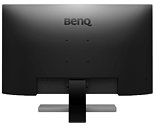Thursday, April 5th 2018

BenQ Announces the EW3270U Monitor: 31.5", 4K, "HDR", AMD FreeSync
BenQ announced availability of their EW3270U desktop PC monitor, which features some well-known quantity in terms of features. The panel itself is a 31.5" affair built upon VA technology, and features 4K resolution (3840 x 2160). There's a 3000:1 contrast ratio, a measly 300 cd/m² brightness (so no, this monitor can't really display HDR content, it can only receive HDR input), a 9 ms response time (with 4 ms gray-to-gray).
There's a somewhat interesting technology at play here though, which BenQ calls Brightness Intelligence Plus Technology (B.I.+ Tech). This tech should somewhat have the unintended effect of wreaking havoc with content: it automatically darkens bright areas so as to reduce contrast with the dark ones. FreeSync was thrown into the display as well, though that should do little to improve its gaming monitor chops. Connectivity-wise, we're looking at a pretty standard 1xDisplayPort 1.2 x, 2x HDMI 2.0, 1x USB-C, and a 3.5 mm audio jack.
There's a somewhat interesting technology at play here though, which BenQ calls Brightness Intelligence Plus Technology (B.I.+ Tech). This tech should somewhat have the unintended effect of wreaking havoc with content: it automatically darkens bright areas so as to reduce contrast with the dark ones. FreeSync was thrown into the display as well, though that should do little to improve its gaming monitor chops. Connectivity-wise, we're looking at a pretty standard 1xDisplayPort 1.2 x, 2x HDMI 2.0, 1x USB-C, and a 3.5 mm audio jack.



11 Comments on BenQ Announces the EW3270U Monitor: 31.5", 4K, "HDR", AMD FreeSync
If there was ever a time and place for a curved display, this is it...
The comment on 300cd/m by the way... while true for HDR, for any normal use going over 200cd/m generally isn't the most pleasant of things either. Good HDR is about a very low black point, not a very high brightness that you can't comfortably look at.
And yes, if you want to work with it for any numberr of hours, you calibrate your display for 120nits. But I think HDR is supposed to show sun flares or reflections (however briefly) that are quite a bit brighter than that. Not saying I want the Sun to stare me in the face when I look at the monitor, but that's how I understand HDR from a technical point of view.
On another note, DP 1.4 is two years old and DP1.3 is 3.5 years old. Why does stuff come out today that only does DP 1.2?
Honestly the current VESA standard stinks incredibly hard; nobody wants to look at 600 or 1000 nits which VESA considers 'the only real standard(s) for true HDR'... but even a 300 nit display can still get a nice little sticker for it. Its the same crap as HD Ready, and 'Dynamic Contrast', and the obvious mindfucks that were attempted at that.
As always don't let marketing and the power of repetition fool you. True HDR displays are extremely rare and extremely pricy. The only non-OLED tech that comes *close* is top-end LCD with a very high amount of local dimming zones. And even that is still not the real thing.
www.tftcentral.co.uk/articles/hdr.htm#ultrahd_premium
read the Contrast / Brightness / Black Depth paragraph ;)
This here is important and the main reason for OLED or a similar tech like what Samsung is trying with micro leds (and failing at :P)
Borrowing from photography, there dynamic range is measured in stops (each stop - double the light amount). This maps directly to contrast. Human eye can distinguish 10-14 stops in a static image (dynamically, more than that). Converting to contrast, that is 1:1024 to 1:16384.
TN or IPS panels can have - and today, usually do have - contrast of 1:1000 (10 stops).
VA panels can do even 1:5000 (as demonstrated by some models) and pretty commonly do 1:3000 (11.5 stops) like this Benq.
Black levels are much more variable based on panel and monitor quality (and target audience) but low black level is easier to achieve on VA panel. There is a reason most TV-s are VA ;)
FALD can help somewhat with contrast but it usually has downsides, primarily haloing even with many zones.
I have an illustrative picture of black levels.
From left to right: LG OLED TV, Asus PG279Q (a bad IPS), Eizo EV2736W (a good PLS)
Monitors are not actually calibrated but are configured to be similar and brightness-wise around 120cd. TV is set to be much brighter. Image on all screens is the same - black test from Eizo Monitor Test.
OLED... does not have a contrast rating due to zero black level. And it shows. In addition to all the positives, also negatives - especially the issues with near-black tones. Generally that is not a problem with the display itself but content which does nto account for such dynamic range. HDR content on a capable screen definitely needs to be 10-bit, if not 12-bit. And this is really not specific to OLED but any actually capable HDR screen.
Back to the topic - 300cd really is not the concern. That is enough for most use cases (I would say even with HDR). 1:3000 on the other hand makes it better than many other "HDR" monitors. It will not really have the wow factor of HDR though, HDR on these remains a marketing gimmick.